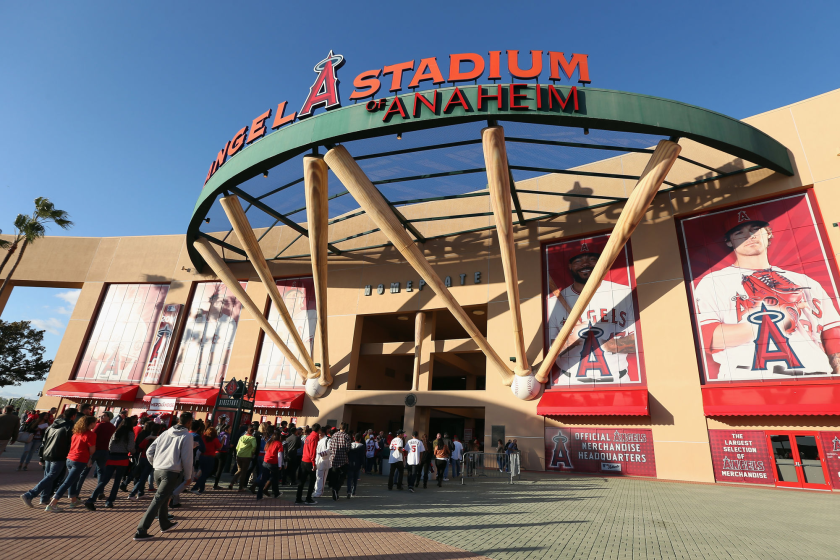Bashing A’s Got Hit by Budget Crunch : Baseball: They hope they can get more from less after payroll cut, banking on stability of lineup.
- Share via
SCOTTSDALE, Ariz. — Baseball, long considered a game of adjustments for hitters and pitchers, also is requiring that skill of its front offices.
The Oakland Athletics emerged from their defeat by the Toronto Blue Jays in last year’s American League playoffs with 15 free agents and a $43-million payroll their market couldn’t sustain.
The initial priority: Retain pitching--primarily free agents Dave Stewart and Mike Moore--and as much of the everyday nucleus as possible while cutting the payroll to $30 million.
The reality: The A’s reflected on the early signings of free-agent pitchers such as Doug Drabek, Greg Swindell and John Smiley and reached two conclusions:
--They would have nothing left for the heart of the lineup--free agents Mark McGwire, Ruben Sierra and Terry Steinbach--if they continued to put the priority on re-signing pitchers Stewart, Moore and Ron Darling.
--They couldn’t be competitive at $30 million.
“We didn’t want to see our nucleus completely disappear,” General Manager Sandy Alderson said of the mid-winter adjustment in the A’s priorities. “We made a concession to what happened in the market and, in some degree, to our fans.
“We were also able to be a little creative in how we structured some of the deals.”
Stewart and Moore were among the free agents who left. McGwire, Sierra, Steinbach and Darling were among those who re-signed. The A’s payroll is about $36 million, and Manager Tony La Russa insists that a team seemingly on the verge of disintegration is capable of extending its division dominance.
“It’s wide open,” La Russa said of the American League West race, which the A’s have won four of the last five years. “Every team has pluses and every team has question marks.
“Had we not spent a little more money and backed off the pitching to keep our everyday club together, we wouldn’t have had a chance to win. Now our pluses give us as good a chance as anyone.”
Said McGwire: “I was only interested in playing for a contender. Sandy and Tony did a great job of keeping the team together. We really only lost two or three guys.
“The way baseball is now, you pay three, four or five guys (a lot of money) and the rest of the team is likely to be different from year to year.”
Eleven of the 29 A’s who were eligible for last year’s postseason roster are no longer with the team.
The major transition occurred during a two-week span in December after Stewart signed a two-year, $8.5-million contract with Toronto and Moore joined the Detroit Tigers for three years at $10 million.
The A’s then guaranteed $77.5 million to McGwire, Sierra, Steinbach and Darling. McGwire will get $28 million for four years, Sierra $28 million for four, Steinbach $14 million for four and Darling $7.5 million for three.
The McGwire and Sierra deals included signing bonuses of $7 million and $5 million, respectively. The front-loading arrangement benefited the club in that it was operating with the revenue from this final year of the national TV contract and benefited the players in that they can shelter the cash against the new tax plan and the possibility of a 1994 lockout.
The A’s might not have cut the payroll as much as they wanted, but they figure to generate revenue through the sale of more scorecards, a requisite now for Oakland fans.
Besides Stewart and Moore, the A’s allowed Jeff Russell, Willie Wilson, Jamie Quirk, Randy Ready and Jeff Parrett to leave as free agents. Third baseman Carney Lansford retired. Shortstop Walt Weiss and designated hitter Harold Baines were traded.
In turn, the A’s retained free agents Kelly Downs, Rick Honeycutt and Goose Gossage, signed free agent Kevin Seitzer to replace Lansford, and signed free agent Storm Davis as a possibility for the rotation.
They also replenished their depth by reaching modest minor league agreements with a bench load of fringe veterans, including Gary Pettis, Bob Milacki, Rich Gedman, Dale Sveum, Edwin Nunez, Jeff Ballard and Rafael Ramirez.
The new A’s lineup has McGwire at first, Lance Blankenship at second, Mike Bordick at shortstop, Seitzer at third, Rickey Henderson in left, Dave Henderson in center, Sierra in right and Steinbach catching. Troy Neel, who drove in 74 runs and led the Pacific Coast League with a .351 average, gets first call at designated hitter.
Dennis Eckersley, the American League’s most valuable player and Cy Young Award winner, remains the closer, and the current rotation includes Bob Welch, Bobby Witt, Darling, Davis and, perhaps, Joe Slusarski.
La Russa said he still scratches his head at times, wondering how the A’s won last year when he used 22 pitchers and put 14 players on the disabled list a club-record 22 times. It is likely that he will have to mix and match again.
The key questions:
--Can Dave Henderson, 34, rebound from a virtually lost season during which he was restricted to 20 games by hamstring and calf injuries?
--Can the enigmatic Rickey Henderson, 34 and in the final year of his contract, sustain a season-long sales pitch?
--Can Welch, 36 and on the disabled list three times last year, regain his Cy Young form of 1991 to anchor a rotation devoid of the big-game reliability of Stewart?
--Can the bullpen produce a set-up man for Eckersley? Can Seitzer fill the Lansford void? Are there leaders to replace Stewart, Lansford and, La Russa added, third base coach Rene Lachemann, now managing the Florida Marlins?
Said McGwire: “I expect the leadership question to be blown out of proportion this spring. The majority of the team is still together. The players know what it takes to win and know when to step forward.”
La Russa didn’t disagree, but he said of Stewart, Lansford and Lachemann: “You’re talking about as good a pitcher, player and coach as any club has ever had. On the other hand, Welch, Darling, Eck and Steinbach are notable leaders, and the Hendersons have been received well at times, too.”
Dave Henderson has to play more than 20 games to provide leadership. He is running well since reporting Wednesday and says he has recovered completely from last season’s leg problems. Rickey Henderson needs to relight his own fire before he can spark anyone else.
La Russa said the A’s are counting on Rickey Henderson’s simmering displeasure with his $12-million contract of the last four years as a spur, but he has yet to report, yet to give any indication that he will be motivated by the prospect of free agency.
“This is the opportunity Rickey has been waiting for,” La Russa said. “He can jump up and make as much (as) or more than anyone in the game. All baseball will be watching to see if he can put a full year together. He can break the bank, and we can be the beneficiary.”
The A’s have to live with that hope. They have tried in vain to trade Henderson, one of the few frustrations for a club that seldom makes personnel mistakes.
Did the A’s do it right last winter? Time will tell. Two things seem certain:
--It will be a surprise if they produce the dominant starting pitching that was the bottom line on three consecutive pennants. They have no left-handed starter, and Todd Van Poppel and other farm hopes still seem a year or more away.
The fragile Welch, the enigmatic Witt and the reborn Darling, 15-10 last year, will have to carry major loads. There are those in the organization who say the decision to let Stewart, 36, and Moore, 33, go made sense on the basis of deteriorating statistics, as well as ballooning economics.
La Russa said there was simply no choice when weighed against the loss of his every day nucleus.
“I expect Stew to be a big winner again,” he said of the pitcher who was 12-10 last year. “He’s determined to prove we made a mistake.”
--It will be a quieter and less controversial year with Jose Canseco gone. The Aug. 31 deal in which Canseco was traded to the Texas Rangers for Sierra, Witt and Russell triggered many of the ensuing moves.
“Jose is a giant talent,” La Russa said. “Nothing he does in that area surprises me, but his priorities were out of whack. We made the trade based on his conduct of the last two or three years. His commitment to winning wasn’t there, and a team in the pennant race doesn’t have the margin of error to put up with that type player.”
More to Read
Go beyond the scoreboard
Get the latest on L.A.'s teams in the daily Sports Report newsletter.
You may occasionally receive promotional content from the Los Angeles Times.










